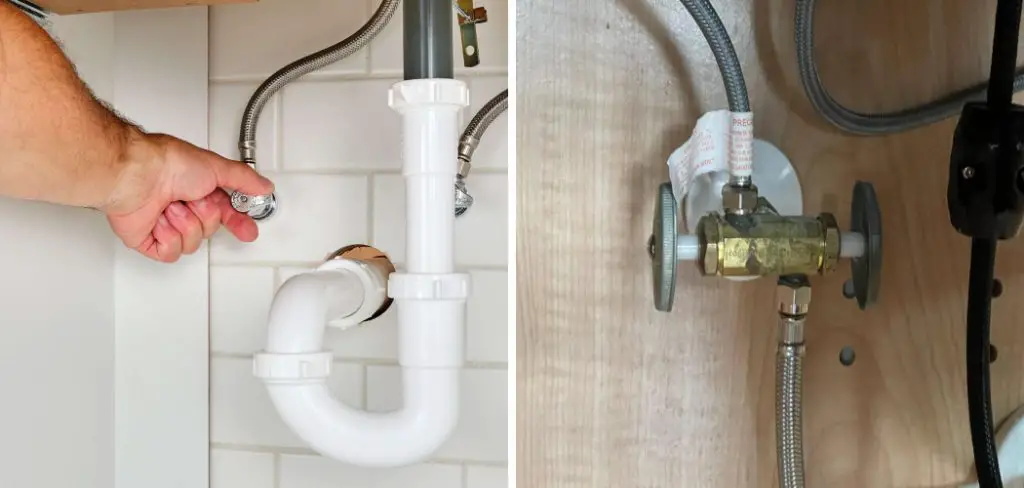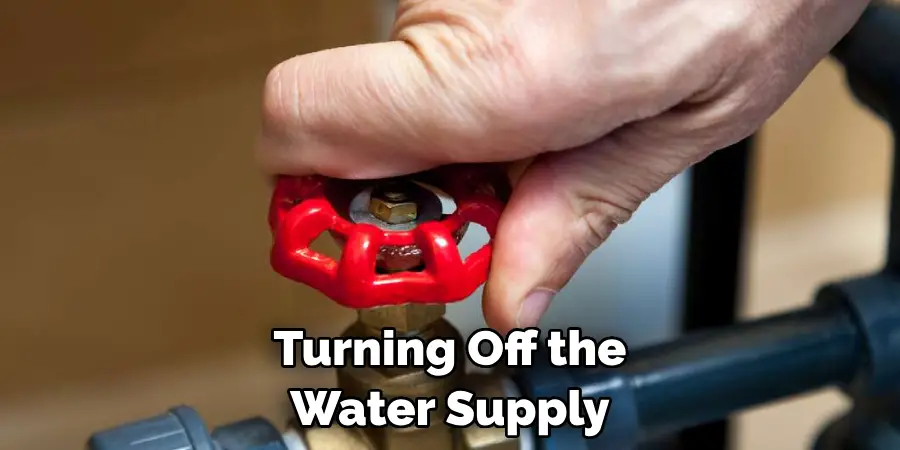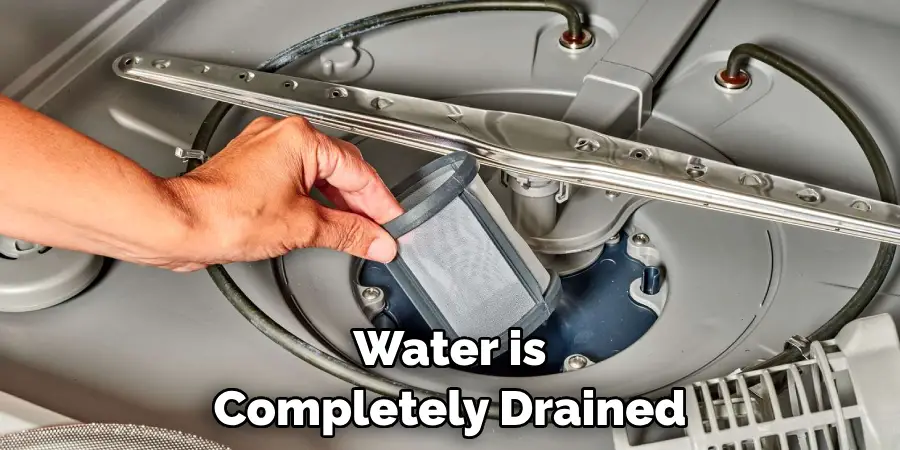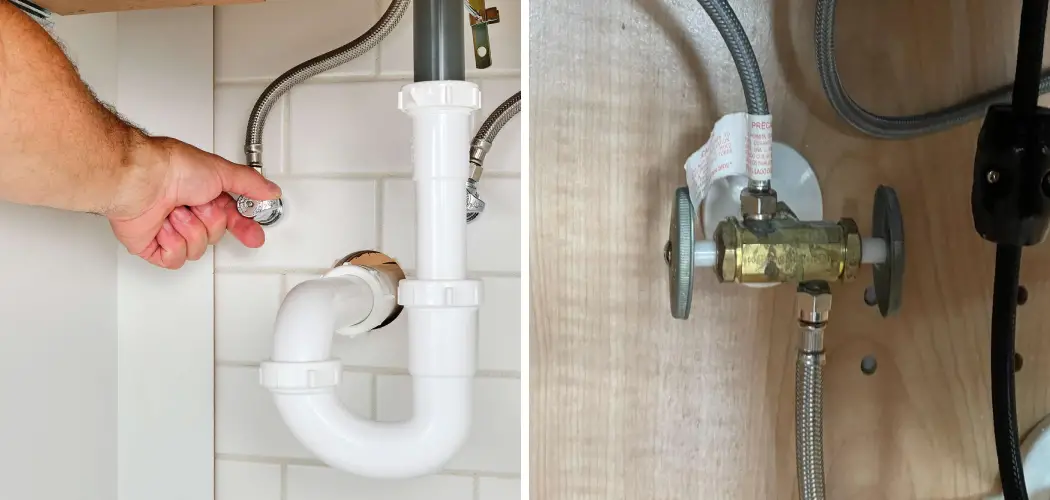The kitchen is the heart of any home, where families gather to share meals, conversation, and laughter. It’s also the place that generates more dirty dishes than anywhere else. Day after day, we load our trusty dishwashers to keep our pots, pans, and plates clean so we can continue cooking and enjoying our meals together.

But what happens when one day your dishwasher refuses to run or fill with water? If you’ve found yourself asking, “Why won’t my dishwasher start?” or scratching your head wondering, “How do I turn off the water to my dishwasher?” – then you’ve come to the right place.
In this blog post, I’ll walk you through the simple steps of how to turn off dishwasher water supply. By the end, you’ll be back washing dishes in no time.
What Will You Need?
Before you start turning off your dishwasher’s water supply, make sure you have the following items on hand:
- A pair of pliers or a wrench (depending on what type of valve you have)
- A bucket or other container to catch any excess water
- A towel to dry your hands and any spilled water
Once you have these items, you’re ready to begin.
10 Easy Steps on How to Turn Off Dishwasher Water Supply
1. Locate the Water Supply Valve
The first step in turning off the water supply to your dishwasher is locating the valve. This can typically be found under the kitchen sink, near the pipes that connect to the dishwasher. It may also be located in a nearby cabinet or on a nearby wall.

2. Turn Off the Water Supply Valve
Once you have located the water supply valve, turn it clockwise to shut off the water flow. This will effectively stop water from entering your dishwasher and allow you to safely work on it without any risk of flooding or leaks. If you cannot turn off the valve by hand, you may need to use a pair of pliers for added leverage.
3. Check for Any Remaining Water
After turning off the water supply valve, checking for any remaining water in your dishwasher’s pipes or hoses is important. You can do this by running a short cycle with no dishes inside or by manually draining any excess water with a towel or bucket. This will ensure that there is no standing water left in your dishwasher that could potentially cause damage when maintenance or repairs are performed.
4. Disconnect the Water Supply Line
The next step is disconnecting the water supply line to the dishwasher. This line is usually a flexible metal or plastic hose from the water supply valve to the dishwasher. To disconnect it, you must unscrew the fitting that connects the line to the valve using your pliers or wrenches. As you loosen the fitting, some residual water may be in the line, so be sure to have your bucket and towel ready.
5. Drain the Water from the Supply Line
After disconnecting the supply line, it’s crucial to drain any excess water from it into your bucket. Hold the end of the supply line over the bucket and allow any remaining water to drain out. This step prevents water from spilling onto your floor when you remove the dishwasher. Once the water is completely drained, you can proceed to the next step.

6. Remove the Dishwasher
Now, it’s time to remove the dishwasher from its position. Most dishwashers are installed in cabinetry or under a countertop. Using a screwdriver, remove any screws that secure the dishwasher to the countertop or cabinets. Carefully pull out the dishwasher – it may be heavy, so you might need some help. Ensure to pull it straight out to prevent any damage to the water supply line or power cord.
7. Disconnect the Power Supply
The next step is to ensure that no electrical power is running to the dishwasher. Locate the power cord and follow it to the outlet. Once found, unplug the dishwasher. If the dishwasher is hardwired into your home’s electrical system, you must turn off the breaker in your electrical panel that powers the dishwasher. This step is crucial for your safety while working with the appliance.
8. Disconnect the Drain Line
After ensuring that the power supply to the dishwasher is cut off, you’ll need to disconnect the drain line. The drain line is usually a flexible plastic hose that carries wastewater from the dishwasher to your home’s plumbing system.
Locate the drain line and use your pliers or wrenches to loosen the clamp that holds it in place. Once loosened, you should be able to pull the drain line off. Be prepared for some water to spill out, so have your bucket and towel ready to catch any spills.
9. Inspect and Clean the Drain Line
Once the drain line is disconnected, it’s recommended to inspect it for any obstructions or buildup that could be causing issues with your dishwasher. Using a flashlight, look inside the line for any visible blockages. You can use a long, flexible brush to clean out the line if necessary. You can move to the final step once you’ve inspected and cleaned the line.
10. Reattach All Components and Restore Power
After ensuring the drain line is clean and clear, the final step is reattaching all disconnected components. Start by restoring the drain line and securing it with the clamp. Follow this by reconnecting the water supply and turning the water valve counterclockwise to restore the water supply.

After that, carefully push the dishwasher back to its position and secure it with the screws that were initially removed. Remember to plug the power cord back into the outlet or turn on the breaker in your electrical panel to restore power. Now, you should test your dishwasher to ensure it’s working properly and has no leaks.
By following these ten easy steps, you can safely and effectively turn off your dishwasher’s water supply. Whether you’re performing maintenance or repairs, it’s important to follow these steps to avoid any potential damage or accidents.
5 Additional Tips and Tricks
- Don’t Procrastinate: It’s easy to put off tasks until the last minute, but try to tackle them as soon as possible. This reduces stress and gives you ample time to tackle unexpected problems.
- Stay Organized: An uncluttered workspace promotes an uncluttered mind. Keep your physical and digital workspaces tidy to increase efficiency and focus.
- Take Regular Breaks: Taking short breaks can boost productivity. Use techniques like the Pomodoro Technique to break your work into manageable chunks.
- Communication is Key: Clear and concise communication can prevent misunderstandings and ensure everyone is on the same page. Effective communication is crucial, Whether in a team or with clients.
- Continuous Learning: Keep up-to-date with your field’s latest trends and developments. You can never know too much! Regular learning will help you stay ahead of the curve.
With these additional tips and tricks, you can take your productivity to the next level! By implementing them into your daily routine, you can work smarter and more efficiently.

5 Things You Should Avoid
- Multitasking: While it may seem like a good idea to juggle multiple tasks simultaneously, it can often lead to reduced productivity and increased stress. Focus on one task at a time for maximum efficiency.
- Neglecting your Health: Long working hours without breaks can cause physical strain and mental burnout. Ensure to maintain a balance, take breaks, and keep yourself hydrated.
- Ignoring Feedback: Feedback, whether positive or negative, is an opportunity to improve. Ignoring it can lead to stagnation and hinder growth.
- Avoiding Challenges: Stepping out of your comfort zone is crucial for personal and professional growth. Avoiding challenges can lead to missed opportunities.
- Procrastinating on Difficult Tasks: It’s tempting to push the complex tasks to the back of the queue, but tackling them head-on can boost your confidence and productivity.
Avoiding these pitfalls can go a long way in enhancing your productivity and overall effectiveness in your work.
Conclusion
In conclusion, how to turn off dishwasher water supply is a simple and essential step in maintaining its efficiency and prolonging its lifespan. Following the steps outlined in this blog post, you can ensure that your dishwasher is always running smoothly without any significant issues. Remember to locate the shut-off valve, turn it clockwise to close it, and test the water supply once it is closed.
It’s also important to clean and maintain your dishwasher regularly to avoid any potential clogs or leaks. Taking these preventative measures will not only save you money on repair costs, but it will also help conserve water and energy.
So remember to turn off the water supply before leaving for vacation, or anytime you won’t be using your dishwasher for an extended period of time. Making these small changes can make a big difference in the long run.
Now, confidently impress your friends with your newfound knowledge about dishwashers! As always, stay tuned for more helpful tips and tricks on maintaining your household appliances. Happy cleaning!

